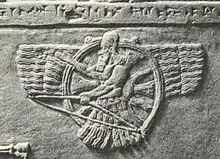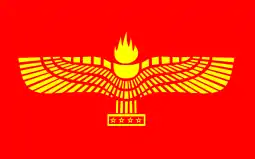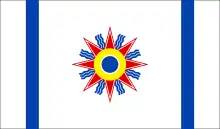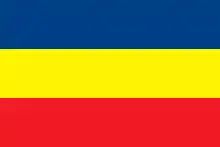Assyrian flag
The Assyrian flag (Syriac: ܐܬܐ ܐܬܘܪܝܬܐ ʾāṯā ʾāṯōrāytā or ܐܬܐ ܕܐܬܘܪ ʾāṯā d-ʾāṯōr)[1][2] is the flag chosen by the Assyrian people to represent the Assyrian nation in the homeland and in the diaspora.
 | |
| Use | Ethnic flag |
|---|---|
| Adopted | 1971 |
| Design | White background with a golden circle at the center, surrounded by a four-pointed star in blue. Four triple-colored (red-white-blue), widening, wavy stripes connect the center to the four corners of the flag. |
| Designed by | George Bit Atanus |
George Bit Atanus first designed the flag in 1968;[3] the Assyrian Universal Alliance, Assyrian National Federation and Bet-Nahrain Democratic Party all adopted it in 1971. The flag has a white background with a golden circle at the center, surrounded by a four-pointed star in blue. Four triple-colored (red-white-blue), widening, wavy stripes connect the center to the four corners of the flag. The figure of pre-Christian Assyrian god Assur, known from Iron Age iconography, features above the centre.
Symbolism
The golden circle at the center represents the sun, which, by its exploding and leaping flames, generates heat and light to sustain the earth and all its living things. The four-pointed star surrounding the sun symbolizes the land, its light blue color symbolizing tranquility.
The wavy stripes extending from the center to the four corners of the flag represent the three major rivers of the Assyrian homeland: the Tigris, the Euphrates, and the Great Zab. The lines are small at the center and become wider as they spread out from the circle. The dark blue represents the Euphrates. The red stripes, whose blood-red hue stands for courage, glory, and pride, represent the Tigris. The white lines in between the two great rivers symbolize the Great Zab; its white color stands for tranquility and peace. Some interpret the red, white, and blue will gather all the Assyrians back to their homeland to stand strong and fight for what they want and what they have gained.[4]
The star on the flag is the old star symbol associated with Shamash, also known as Utu, the sun deity also associated with the planet Saturn. He was worshipped in the ancient Mesopotamian region. He was apparently the deity who provided leaders like Hammurabi, Ur-Nammu, and Gudea with divine laws.
The archer figure symbolizes the pre-Christian god Assur.[5]
Previous flags
Prior to World War I, Western Assyrians from the Tur Abdin region of Turkey designed an Assyrian flag consisting of a horizontal tricolor with the colors pink, white, and red, with three white stars at the upper hoist.[6] The pink, white, and red bars represented the loyalty, purity, and determination of the Assyrian people, and the three white stars represent the three names or components of the Assyrian nation, Assyrians, Syriacs, and Chaldeans.[7][8] This flag was used during delegation meetings with Assyrian politicians and Western powers post World War I. It was also in use by the Assyrian National Federation, later renamed the Assyrian American Federation and the Assyrian American National Federation, from its founding in 1933 until 1975 when they adopted the current Assyrian flag.[7][8]
During the First World War, the Assyrian volunteers commanded by Agha Petros used a red flag with a white cross. Agha Petros' personal standard was the flag of the Volunteers but made of silk, with a golden fringe added, and the words "Trust God and follow the Cross" written in Assyrian above the cross.[9][10]
Gallery
Variants

.svg.png.webp) The Assyrian flag with the image of Assur in shades of gold and blue, adopted by the Assyrian Universal Alliance[12]
The Assyrian flag with the image of Assur in shades of gold and blue, adopted by the Assyrian Universal Alliance[12].svg.png.webp)
.svg.png.webp) The Assyrian flag without the image of Assur. This version has been used by the Nineveh Plain Protection Units.[15]
The Assyrian flag without the image of Assur. This version has been used by the Nineveh Plain Protection Units.[15]
Inspirations

 The "feather-robed archer" figure in the 1968 flag is inspired by Assyrian Empire period iconography.
The "feather-robed archer" figure in the 1968 flag is inspired by Assyrian Empire period iconography..svg.png.webp) A stylized version of the sun symbol of Shamash
A stylized version of the sun symbol of Shamash Star symbol in the Mor Gabriel monastery
Star symbol in the Mor Gabriel monastery
Other flags


 Tricolor used by the Syriac Union Party and Syriac Military Council representing Assyrian-Syriac people in SDF-controlled Northern Syria [19]
Tricolor used by the Syriac Union Party and Syriac Military Council representing Assyrian-Syriac people in SDF-controlled Northern Syria [19].svg.png.webp) The flag of Iraq 1959-1963 included a red Star of Ishtar symbolic of the Assyrian minority.
The flag of Iraq 1959-1963 included a red Star of Ishtar symbolic of the Assyrian minority.
See also
References
- http://www.assyrianlanguages.org/sureth/list.php?initial=%27
- http://assyrianapp.com/feed-items/%DC%9F%DC%98%DC%A0%DC%9D%DC%97%DC%9D%CC%88-%DC%92%DC%98%DC%AA%CC%88%DC%A2%DC%90-%DC%90%CC%83%DC%9F%DC%98%DC%A1%DC%90-%DC%A0%DC%90-%DC%A1%DC%A8%DC%90%DC%A0%DC%97%DC%98%CC%88%DC%A2-%DC%95%DC%AB%DC%A0/
- "The History and Meaning Behind the Assyrian Flag". Assyrian Cultural Foundation. 2017-03-27. Retrieved 2020-06-27.
- Ashurian, Homer (2009-02-17). "The Origins and Description of the Assyrian Flag". AUA.net. Retrieved 2012-08-17.
- "The Origins and Description of the Assyrian Flag" by Homer Ashurian, Assyrian Universal Alliance, 03-1999 Archived 17 February 2009 at the Wayback Machine
- "The History and Meaning Behind the Assyrian Flag". Assyrian Cultural Foundation. 2017-03-27. Retrieved 2020-06-27.
- "The Old Assyrian Flag". Chaldeans On Line. Archived from the original on 5 January 2006. Retrieved 21 June 2019.
- AANF. "HISTORY". Assyrian American National Federation. Archived from the original on 7 February 2005. Retrieved 21 June 2019.
- Lindenmayer, Sarah (2018). Debt of Honour: How an Anzac saved the Assyrian people from Genocide. Australian Self Publishing Group. p. 21. ISBN 9780648317722. Retrieved 21 June 2019.
- S.G. SAVIGE. D.S.O., M.C. (1920). STALKY'S FORLORN HOPE. McCubbin.
- "Assyria". Crwflags.com. Archived from the original on 12 October 2008. Retrieved 16 November 2008.
- "The Origins and Description of the Assyrian Flag" by Homer Ashurian, Assyrian Universal Alliance, 03-1999 Archived 17 February 2009 at the Wayback Machine
- Kiwarkis, Gaby (23 April 2010). "Assyrians Honor New Zealand War Hero, Dedicate Genocide Plaque". Assyrian International News Agency. Retrieved 29 March 2019.
- Assyrian National Broadcasting (26 Mar 2017). "Happy Assyrian New Year!". Youtube. Assyrian Aid Society of America. Retrieved 29 March 2019.
- Nineveh Plain Protection Units (NPU). "NPU raised the Iraqi, Assyrian & NPU flags in Baghdedeh". Youtube. NPU NinevehPlainProtectionUnits. Retrieved 1 October 2018.
- http://www.britannica.com/EBchecked/topic/538274/Shamash
- "Syriac-Aramaic People (Syria)". Crwflags.com. Archived from the original on 4 December 2008. Retrieved 16 November 2008.
- http://chaldeanflag.com/flag.html
- https://www.reddit.com/r/syriancivilwar/comments/60rpny/syriac_miliary_council_waves_new_flag/

